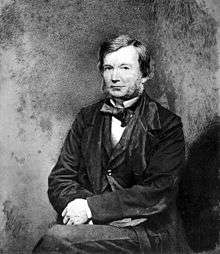Bennet Woodcroft
Bennet Woodcroft FRS (20 December 1803 – 7 February 1879) was an English textile manufacturer, industrial archaeologist, pioneer of marine propulsion, a leading figure in patent reform and the first clerk to the commissioners of patents.[1]
Benet Woodcroft | |
|---|---|
 by William Walker c.1860 | |
| Born | 20 December 1803 Heaton Norris, Lancashire |
| Died | 7 February 1879 (aged 75) |
| Nationality | British |
| Occupation | Engineer |
| Engineering career | |
| Discipline | Mechanical engineer |
Biography
Woodcroft was born in Heaton Norris, Lancashire. He was the founder of the Patent Office Library, now part of the British Library, and of the Patent Museum, whose collections are now in the Science Museum.[2][3]
Woodcroft was later Professor of Machinery at University College London.[2]
He married Agnes Bertha Sawyer (7 September 1833 – 10 March 1903[4]) in Hampstead in the September Quarter of 1866. She was born in Bosworth, Leicestershire. At this time he was 63 and she 33.[5] They had no children. On the 1871 census they lived alone with servants, on the 1881 census she is widowed living with the cook only.
Woodcroft died in 1879 and is buried in Brompton Cemetery, London.[6][3] His portrait is in the National Portrait Gallery.
Work
Woodcroft patented fundamental improvements in textile machinery and ship propulsion, and this in turn led to an absorbing interest in the history of the patent procedure. As a result of a reorganisation of the British Patent Office in 1852, he became Superintendent of Specifications. This gave him the opportunity to develop a private collection of historical machinery.
When the South Kensington Museum was being planned in the mid-1850s, the Patent Office, through Woodcroft, was invited to assemble a collection of industrial devices for display. When the Museum opened in 1857, the building incorporated a separate Patent Office Museum and Woodcroft remained its driving force until his retirement in 1876.
A born collector, Woodcroft displayed a passion for securing notable items of historical machinery. 1862 was a particularly fruitful year, when due to his efforts, his museum secured Puffing Billy the world's oldest surviving steam railway locomotive (1814), Stephenson's Rocket (1829), which set the design standard for locomotives, and the engine of Henry Bell's Comet (1812), the first steamship to be operated commercially in Europe.[7]
A letter to his subordinate at South Kensington typifies his single-minded approach: "Get the Comet engine in all its filth" he commanded, emphasising the urgency of the quest. The Patent Office Museum also acquired several examples of stationary steam engine, including a Boulton and Watt beam engine which was the oldest surviving of its type in the world.
Without Woodcroft it is doubtful that some of the most important artefacts of the first industrial revolution would have ever been preserved.
Publications
- Bennet Woodcroft. Steam navigation. Reprinted from Transactions of Society of Arts, 1847.
- Bennet Woodcroft. A sketch of the origin and progress of steam navigation from authentic documents with illustrations drawn by J.C. Bourne and lithographed by C.F. Cheffins. 1848
- Bennet Woodcroft. Patents for inventions. Abridgements of specifications relating to sugar. A.D. 1663–1866. Great Britain. Patent Office (1871)
- as editor: The Pneumatics of Hero of Alexandria, translated from the original Greek by J. W. Greenwood (1851).[8]
See also
References
- "Bennet Woodcroft, F.R.S." Scientific American. New York: Munn & Co. 40 (12): 181. 22 March 1879.
- Jamieson, D. R.; Woodcroft, Bennet (1969) [1854]. "Introduction". Alphabetical Index of Patentees of Inventions. London: Evelyn, Adams & Mackay. pp. v–viii. Retrieved 12 June 2019.
- Sutton, C. W. (1909). "Woodcroft, Bennet (1803-1879)". In Lee, Sidney (ed.). The Dictionary of National Biography: Whichcord–Zuylestein. 21. New York: The Macmillan Company. pp. 858–859. Retrieved 12 June 2019.
- "Mrs. Agnes Bertha Woodcroft, Deceased". The London Gazette (27556). 26 May 1903. p. 3397. Retrieved 12 June 2019.
- Spear, Brian (June 2012). "Bennet Woodcroft – Patent information pioneer". World Patent Information. 34 (2): 159–162. doi:10.1016/j.wpi.2012.01.005.
- Stephenson, R. (June 2002). "Brompton Cemetery: List of notable occupants". Archived from the original on 23 August 2006.
- Whetstone, David (20 July 2017). "It's a done deal - Rocket's coming home and here's why its pulling power is undiminished". ChronicleLive. Trinity Mirror North East. Retrieved 12 June 2019.
- "Review: The Pneumatics of Hero of Alexandria, translated from the original Greek by J. W. Greenwood, edited by Bennet Woodcroft". The Athenæum. London (1223): 380. 5 April 1851.
- MacLeod, Christine (2007). Heroes of Invention: Technology, Liberalism and British Identity, 1750–1914 (illustrated ed.). Cambridge University Press. p. 260. ISBN 9780521873703. Retrieved 27 November 2015.
External links
| Wikimedia Commons has media related to Bennet Woodcroft. |
- Bennet Woodcroft and the Patent Office Museum collection, Science Museum website
- American history Bennet Woodcroft Spiral propeller model, 1832
- Science Museum Model of stern of vessel fitted with adjustable pitch screw propeller, 1857